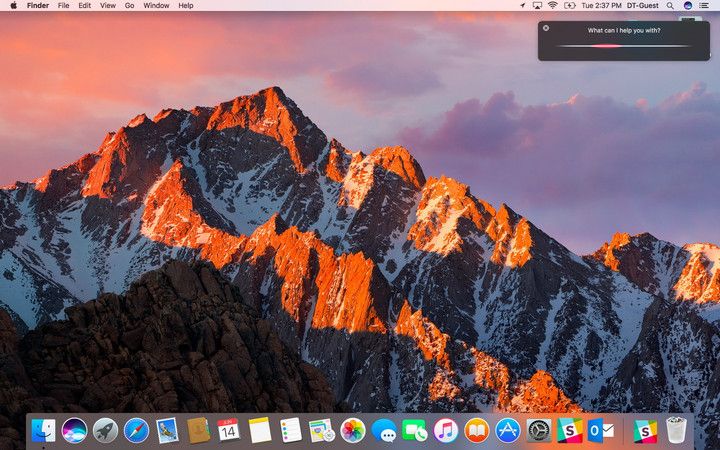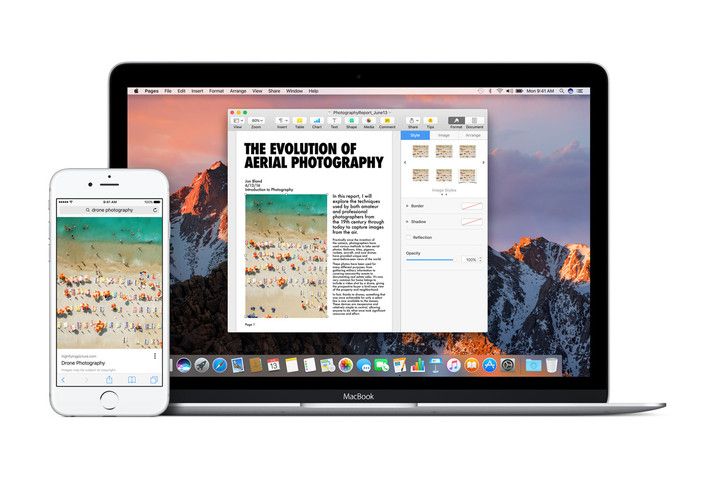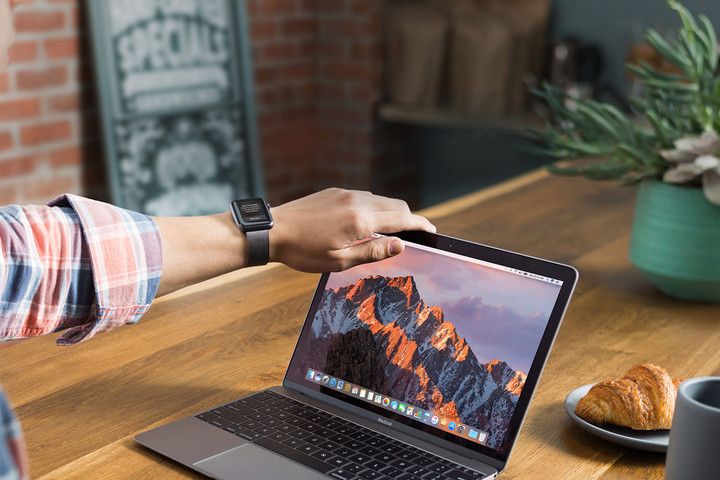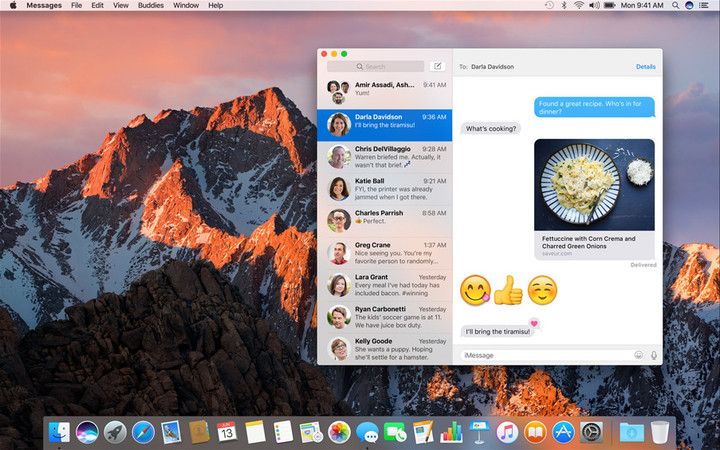HERE ARE THE 5 FEATURES THAT WILL MAKE YOU UPGRADE TO MACOS SIERRA.
Nearly every summer brings the promise of sunshine, marigolds, and — in the case of Apple — a new iteration of Mac OS X. This year is no different, as the Cupertino-based company utilized its WWDC keynote to introduce developers and Apple users to its forthcoming operating system, MacOS Sierra.
Name changes aside, the newest OS promises to bring a host of new features designed to capitalize on the system’s tight integration with WatchOS and iOS, Apple’s mobile OS for the iPhone and iPad.
Many of the features, namely Siri, take a cue directly from the iOS playbook, while others, like the Universal Clipboard, introduce brand-new functionality to the Apple ecosystem. Below are five of the most convenient and useful features coming to a Mac near you later this year — assuming your machine is newer than 2009, that is.
Siri integration

Siri is, hands-down, the biggest addition to MacOS. The feature has been a staple of iOS since 2011, and has been rumored to make an appearance on the Mac for years. Craig Federighi, Apple’s vice president of software engineering, was quick to highlight just how convenient the virtual assistant will be on Mac, especially when paired with the software’s latest advancements.
The intuitive feature will live in both the menu bar and dock, but like the software’s mobile counterpart, it will require manual activation. Once activated, Siri will listen to your inquiry and respond appropriately. You’ll be able to use the feature to play music, launch apps, and look up miscellaneous information on the web, among other tasks.
In addition, Siri will be able to search your files in lieu of Spotlight, allowing you to locate files based on their location, origin date, document type, and other complex facets that might further define your results. You’ll also be able to click-and-drag whatever results you find to other windows, or to the notifications pane.
Apple even announced that it’s opening up the mobile version of Siri to third-party developers, something that would expand the software’s functionality to non-native apps and possibly impact the desktop iteration of Siri in the future.
A shared, Universal Clipboard

Continuity was first created to provide a seamless experience between the Mac and various devices, one that allows users to start an action on one device and finish on another. While Handoff and Cellular Calls — which allows you to make or receive cellular calls on a Mac, iPad, and iPod touch, in addition to your iPhone — remain the system’s two flagship features nearly two years down the line, the inclusion of a shared clipboard in MacOS Sierra could change that.
The aptly-titled Universal Clipboard will let you copy images, video, text, and other data from your iPhone, and easily paste it on a nearby Mac, or vice versa. It’s a handy little feature that’s sure to make jotting down that grocery list a little easier.
Auto Unlock for Apple Watch users

For most people, entering a passcode before using your computer isn’t exactly a burden. But it often seems unnecessary given just how connected our devices have become with one another.
Thankfully, MacOS Sierra includes a subtle feature called Auto Unlock, which works in conjunction with WatchOS 3 to make life a little easier for Apple Watch users. With Auto Unlock, you merely need wake your Mac from sleep mode while wearing the Watch to gain access to your machine. Just walk up and open your laptop — and time-of-flight networking protocols will take care of the rest.
Redefined Photos
Photos are an important aspect of our lives, as they allow us to capture and share our memories with our family, friends, and complete strangers (thanks Instagram). Apple knows this, and the new-and-improved Photos application will provide users with a better way to sort, categorize, and present the photos and video they capture on the daily. The recently-announced Places and Faces feature, for instance, will look to capitalize on Apple’s “Advanced Computer Vision,” and thus work to learn the people in your photographs and place their whereabouts on a map using GPS metadata.
The new technology will also let you to search for locations, scenes, individual objects, and people. The intuitive search function can provide you with images of every sunset you’ve ever captured, for example, or present you with every image you’ve taken that contains a bicycle. Photos will also include a separate People and Places albums, so you can look up images of your special someone or chart your photo ventures on an interactive map that beautifully showcases your travel exploits.
MacOS Sierra will introduce Mac users to Memories, a feature that automatically creates contextualized videos and slideshows based around people, places, events, and a wealth of other information housed in your metadata and beyond. You’ll be able to quickly tweak these so-called “memories” to fit a specific length (short, medium, long) or mood, the latter feature of which lets you outfit your photo and video montages with music that could be defined as “Epic” or “Happy,” among other attributes.
Livelier Messages

Messages are certainly not a new addition to MacOS Sierra, but never before have they been outfitted with the kind of personality afforded by Apple’s forthcoming OS. With iOS 10 and Sierra, users will be able to send larger emojis and play videos and preview links from directly within the conversation. When responding, you’ll also be able to to tack a heart, a thumbs up, a series exclamation points, or other icons onto a message bubble with what’s known as Tapback. It’s not a revolutionary feature, but it adds a bit of fun to an app that rarely meant to be taken seriously.
In regards to other message features coming to iOS 10, it’s hard to say whether Apple will carry them over to the desktop version of iMessages. Apple showcased a laundry list of new features that are set to make their in the fall, including background animations, stickers, and predictive emojis. Users will also to make payments with iOS 10, and send heart beats, drawings, and Snapchat-like edited photos without ever leaving the app.
Apple is even opening up iMessage to developers. Many of the aforementioned features make use of the 3D Touch technology found on the iPhone 6S and 6S Plus, but it’s possible that they may find their way to Macs outfitted with a Force Touch trackpad. This, however, remains to be seen, as Apple has yet to definitively announce such inclusions in MacOS Sierra.
MacOS Sierra launches is slated for release in late 2016, with a public beta set to kick off in July. A developer beta is also available right now, however, you’ll need an official developer account with Apple in order to download and install the OS.

for blue colourFollow us on Twitter - @akatechsolution / @smartdevicess
Leave a Comment
Let Millions of People know about your Product(s) / Service(s)
Target a Specific Audience on different News Categories
Our Partners
"Making the simple complicated is commonplace; making the complicated simple, awesomely simple, that's creativity"
- Charles Mingus






















































.png)














